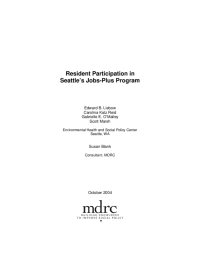Resident Participation in Seattle’s Jobs-Plus Program
In 1998, the Seattle Housing Authority launched the Jobs-Plus Community Revitalization Initiative for Public Housing Families (“Jobs-Plus” for short) in its Rainier Vista housing development as part of a national research demonstration to test an innovative strategy for promoting employment among public housing residents. Jobs-Plus offered all working-age, nondisabled Rainier Vista residents assistance finding jobs and rent-related financial incentives to help make work pay. It also tried to mobilize residents’ social networks to promote and support work. A year after the demonstration began, the housing authority received a federal HOPE VI grant to tear down and rebuild Rainier Vista. Faced with losing their homes, residents had to contend with the extra anxieties, uncertainties, and disruptions that are associated with temporary or permanent relocation. This situation — and the fact that Rainier Vista’s tenant population included immigrants and refugees who spoke 22 different languages and came from many different countries — created a challenging context for Jobs-Plus’s program operations.
Key Findings
- Despite the extra hurdles of serving tenants who hailed from different cultures and who faced relocation, Seattle Jobs-Plus succeeded in engaging a majority of residents in work-related services or supports. Nearly two-thirds (64 percent) of working-age, nondisabled residents obtained employment-related assistance from Jobs-Plus and/or received its rent incentives. These results are within the range observed at other Jobs-Plus sites that had no redevelopment and far less ethnic diversity. Nevertheless, HOPE VI’s objective of sustaining services for residents after they moved to off-site housing proved difficult.
- A culturally sensitive strategy to reach immigrants fostered the program’s appeal to residents but also made it harder, at first, to recruit U.S.-born tenants. Special efforts to engage immigrants — such as the use of resident outreach workers, culturally sensitive marketing campaigns, and partnerships with refugee-focused service organizations — meant that a foreign heritage or the lack of English proficiency seldom kept residents from learning about or participating in Jobs-Plus. But these outreach efforts initially led other residents to conclude that Jobs-Plus was a program for immigrants. This experience underscores that multicultural outreach efforts need to be sensitive to all constituencies.
- The program staff’s commitment and creative approaches to resident empowerment and community-building, combined with the support of the housing authority, helped residents play an unusually influential role in decisions affecting Jobs-Plus and HOPE VI. Although time-consuming, efforts to empower residents and build community helped residents negotiate successfully with the housing authority over relocation and redevelopment issues, become engaged in shaping Jobs-Plus services, and improve on a previously adversarial relationship with the housing authority.
Seattle’s experiences with Jobs-Plus illustrate how a place-based employment initiative can operate within a complex, multiethnic environment and become the vehicle for delivering the self-sufficiency component of a broader housing redevelopment initiative. A forthcoming report will examine the program’s effects on residents’ employment and earnings.







